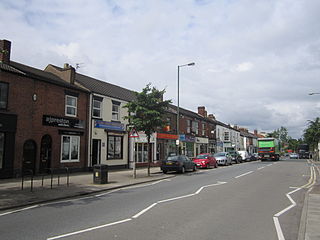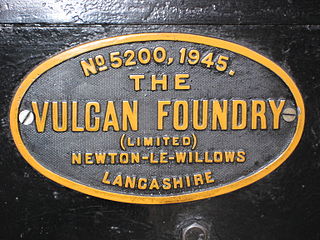Related Research Articles

The London and North Western Railway was a British railway company between 1846 and 1922. In the late 19th century, the LNWR was the largest joint stock company in the world. In 1923, it became a constituent of the London, Midland and Scottish (LMS) railway, and, in 1948, the London Midland Region of British Railways. The LNWR's main line remains today as the English and Welsh portions of the West Coast Main Line.

Earlestown is a town in the Metropolitan Borough of St Helens in Merseyside, England. At the 2011 Census the town had a population of 10,830.

Newton-le-Willows is a market town in the Metropolitan Borough of St Helens, Merseyside, England. The population at the 2011 census was 22,114. Newton-le-Willows is on the eastern edge of St Helens, south of Wigan and north of Warrington.

Wolverton is a constituent town of Milton Keynes, England. It is located in the north-west of the city, beside the West Coast Main Line, the Grand Union Canal and the river Great Ouse. It is the administrative seat of Wolverton and Greenleys civil parish.

Earlestown railway station is a railway station in Earlestown, Merseyside, England, and one of the few "triangular" stations in Britain.

The Vulcan Foundry Limited was an English locomotive builder sited at Newton-le-Willows, Lancashire.
The Warrington and Newton Railway was a short early railway linking Warrington to the Liverpool and Manchester Railway at Newton, and to pits at Haydock, nearby. It opened in 1831.

Newton-le-Willows railway station is a railway station in the town of Newton-le-Willows, in the Metropolitan Borough of St Helens, and at the edge of the Merseytravel region. The station is branded Merseyrail. The station is situated on the northern route of the Liverpool to Manchester Line, the former Liverpool and Manchester Railway which opened in 1830. It is a busy feeder station for nearby towns which no longer have railway stations, such as Golborne, Billinge and Haydock. There is also a complimentary bus shuttle service to Haydock Park Racecourse on certain racedays.
The Liverpool Rifles was a unit of the Territorial Army, part of the British Army, formed in Lancashire as a 'Rifle Volunteer Corps' (RVC) in 1859, becoming a battalion of the King's Regiment (Liverpool) in 1881. It saw action on the Western Front in the First World War and later became a searchlight unit of the Royal Artillery in the Second World War.

The Wolverton and Stony Stratford Tramway was a narrow gauge street tramway connecting Wolverton railway station and the Wolverton Works of the London and North Western Railway (LNWR) with Stony Stratford, Buckinghamshire. Although its financial situation was always precarious, except for a period of just under two years between 1889 and 1891, the line was in continuous operation from 1887 to 1926. Between May 1888 to December 1889, an extension also ran from Stony Stratford to Deanshanger in Northamptonshire, via Old Stratford. Unusually for a British street tramway, it was worked entirely by steam locomotives, and was the last of its type to remain in operation.
Malcolm Stewart McCorquodale, 1st Baron McCorquodale of Newton, KCVO, PC was a British businessman and Conservative politician.
Sir Charles Edward James Louis William John Hamilton, 1st Baronet was an English businessman and Conservative politician.
The Liverpool Brigade, later 165th (Liverpool) Brigade was an infantry brigade of Britain's Volunteer Force that served during World War I with the 55th Division of the British Army. During World War II, again as part of the 55th Infantry Division, the brigade remained in the United Kingdom.
Parkside railway station was an original station on the Liverpool and Manchester Railway. It then became the interchange station between lines when the Wigan Branch Railway opened in 1832, moving to the physical junction of the two lines in 1838. The station continued as an interchange until being by-passed in 1847 when a west curve was opened to facilitate north–south links that did not go through the station. Traffic declined further after the Winwick cut-off opened in 1864 leading to closure in 1878.
The Lancashire (Fortress) Royal Engineers was a volunteer unit of Britain's Royal Engineers formed in 1884 to defend the Mersey Estuary. As well as serving in this role it also provided specialist engineer units in both World Wars, losing many men in a shipping disaster during the Greek Campaign. Its descendants continued to serve in the Territorial Army until 1967.

Lowton railway station served the village named Town of Lowton to the east of Newton-le-Willows and south of Golborne.
Sir Richard Moon, 1st Baronet (1814–1899) was the leading executive of the London and North Western Railway (LNWR) during its heyday as the largest public company in the world. He was chairman from June 1861 until he retired on 22 February 1891.
The Bolton Rifles, later the 5th Battalion, Loyal North Lancashire Regiment, was a volunteer unit of the British Army from 1859 until 1967. It served on the Western Front during the First World War, and in the Far East during the Second World War, when one battalion was captured at the Fall of Singapore.

The 5th Battalion, King's Regiment (Liverpool) was a volunteer unit of the King's Regiment (Liverpool) of the British Army. It traced its heritage to the raising in 1859 of a number rifle volunteer corps in Liverpool, which were soon consolidated into the 1st Lancashire Rifle Volunteer Corps (RVC). It was affiliated to the King's Regiment (Liverpool), and became its 1st Volunteer Battalion of the regiment. In 1908 the battalion was transferred to the new Territorial Force as the 5th Battalion, King's Regiment (Liverpool). It saw active service on the Western Front during World War I, as did its second line second-line battalion, and even a garrison battalion. Before World War II it again formed a second line battalion. Both served in home defence, but the 5th King's landed in Normandy on D Day as part of a specialist beach group 1939. When the Territorial Army was reduced in 1967, the 5th King's became a company of the Lancastrian Volunteers.
The Liverpool Press Guard was a Rifle Volunteer Corps raised in the city of Liverpool in Lancashire, North West England, in 1861. Initially drawn from the newspaper and printing trades, it later recruited more widely in the Everton and Ormskirk areas. In 1881 it became a battalion of the King's. A detachment served in the Second Boer War, and two battalions saw action during World War I distinguishing themselves at the Battle of Loos, on the Somme, at Ypres and at Cambrai. It fought in the Battles of the Hindenburg Line in 1918 and was the first unit to liberate Lille in October 1918. The battalion was amalgamated into the Royal Engineers after the war.
References
- 1 2 3 4 "M'CORQUODALE & CO. / THE LIVERPOOL PRINTING AND STATIONERY CO. LTD". Commercial Overprints. Retrieved 19 March 2018.
- ↑ "Newton Station". Newton Heritage Trail. Retrieved 19 March 2018.
- ↑ "McCorquodale Printing Company, Wolverton" (PDF). Discover Milton Keynes. Retrieved 19 March 2018.
- ↑ Ian F.W. Beckett, Riflemen Form: A Study of the Rifle Volunteer Movement 1859–1908, Aldershot: Ogilby Trusts, 1982, ISBN 0 85936 271 X, p. 61.
- ↑ Ray Westlake, Tracing the Rifle Volunteers, Barnsley: Pen and Sword, 2010, ISBN 978-1-84884-211-3, pp. 146, 151.
- ↑ Army List, various dates.
- ↑ E.H.G. Roberts, The Story of the "9th King's" in France, Liverpool: Northern Publishing, p. 7.
- ↑ "No. 25922". The London Gazette. 9 April 1889. p. 2009.
- 1 2 "George McCorquodale". The Peerage. Retrieved 19 March 2018.
- ↑ "Willow Park". Newton Heritage Trail. Retrieved 19 March 2018.
- 1 2 "Malcolm Stewart McCorquodale, Baron McCorquodale Of Newton-le-willows". Epsom and Ewell History Explorer. Retrieved 19 March 2018.